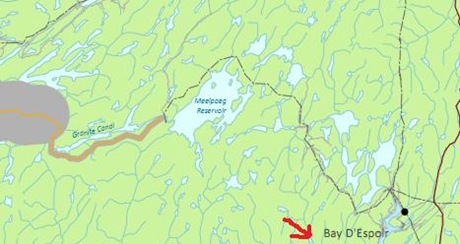Kathy Dunderdale, Ed Martin and their supporters have a basic problem.
In 30 seconds, opponents of the multi-billion project can give a simple, coherent, and unassailable reason why they oppose the project.
In 30 minutes or 30 days or 30 weeks or even 30 months, the provincial Conservatives and Nalcor haven’t been able to provide a thorough, coherent argument why people should back their deal.
Take the consumer price for electricity as a case in point.
Your humble e-scribbler opposes Muskrat Falls because the people who own the resource should not have to pay the full price for development plus a profit for the companies involved while customers outside the province will get the electricity at a discount.
Then-natural resources minister Kathy Dunderdale put the cost of Muskrat Falls power on the table this time last year - November 22, 2010 - and your humble e-scribbler put it right there so people would not forget it:
…in terms of when we bring that on in 2017 that’s the cost in 2017, $165, or excuse me it’s $143 a megawatt hour.
That works out to a range of between 14.3 cents per kilowatt hour and 16.5 cents per kwh.
That’s not the final consumer price, incidentally. That’s the cost to generate electricity from Muskrat Falls. What consumers in this province will pay on the electricity bills will be something higher than that.
Last April, now-premier Kathy Dunderdale confirmed that Muskrat power would cost taxpayers in Newfoundland and Labrador at least 14.3 cents per kilowatt hour. And then she added the point about exports:
Mr. Speaker, Nova Scotia needs power. They need power and they can provide it to themselves for 10 cents or 11 cents a kilowatt hour. They are not going to buy it from us, Mr. Speaker, for 14.3, so we have to go into the market and sell at what the market can bear
Nova Scotians weren’t going to pay that much for electricity in April and that is still their position.
On Wednesday, local news media reported comments by Emera officials to the Nova Scotia legislature’s natural resources committee on October.
Andrew Younger (Lib. Dartmouth East): You undoubtedly are aware that people are talking 14, 15, 16 cents a kilowatt hour, and I do understand that doesn’t mean that’s what you pay on the bill because there are lots of other things and it averages in with the other sources but is that the sort of . . .
Chris Huskilson, CEO, Emera: Well that won’t make it. That kind of number won’t make it.
MR. YOUNGER: Why?
MR. HUSKILSON: It’s too high, so it has to be lower than those kinds of numbers.
MR. YOUNGER: That’s good.
MR. HUSKILSON: We won’t bring forward something that is not going to make it.
Huskilson knows he won;t have to worry about those sort of prices. The working agreement between Nalcor and Emera guarantees Emera a 35 year supply of electricity in exchange for the $1.2 billion cost of a transmission line from Newfoundland to Cape Breton.
Former Premier Roger Grimes has called that free electricity and, in essence, it is. Even if you spread that $1.2 billion over the 35 years, the cost to Nova Scotia – even though it is entirely notional – works out to something like 3.5 cents per kilowatt hour.
Emera can buy electricity beyond that base amount. They will pay around nine cents per kilowatt hour for it under the working agreement. Even with the anticipated inflation escalators, Emera wouldn’t pay anything close to the real cost of Muskrat electricity ever.
Ever.
This is a sweet deal for Emera. They get to do business in Newfoundland and Labrador, with a profit guaranteed by the province’s public utilities board.
But on top of that, Emera will get what Chris Huskilson told the legislative committee a couple of times: 35 years of electricity at a fixed price.
No escalator.
Fixed.
Emera officials used that term quite a bit:
- “Rate stability - it has a long-term fixed cost to it.”
- “To go over the advantages of Lower Churchill, it’s 35 years of clean, renewable energy at a fixed cost.”
- “No, in the long run it does stabilize rates because when it comes in, it’s a fixed contract for 8 per cent to 10 per cent of our load for 35 years, so that will have a stabilizing influence on prices.”
Nova Scotians have a fixed price for 35 years. That’s almost as good as Quebec scored on Churchill Falls in 1969.
In practical terms, even if you accept that 3.5 cents per kwh for the guaranteed block of power, inflation will reduce the cost of Emera’s electricity to almost nothing over time.
Newfoundlanders and Labradorians, on the other hand, will always have to pay to cover the full cost of the project and guarantee a profit besides that for the companies involved.
Their costs will go one way: up.
Go back to that starting comment:
Your humble e-scribbler opposes Muskrat Falls because the people who own the resource should not have to pay the full price for development plus a profit for the companies involved while customers outside the province will get the electricity at a discount.
It won’t even take 30 seconds to read.
The rest is explanation.
Now try and find Nalcor’s explanation of what the people in the province will pay for electricity.
Good luck.
They’ve avoided it like the plague.
- srbp -
Related:


